January 1 (Eastern Orthodox liturgics)
December 31 - Eastern Orthodox liturgical calendar - January 2
All fixed commemorations are observed by Orthodox Churches on 1 January of the Julian calendar ('Old Calendar'), which equates to January 14 on the New Style calendar.[note 1]
For January 1 (New Style), Orthodox Churches on the Old Calendar commemorate the Saints listed on December 19.
Saints
- Martyr Theodotus, by the sword.[6][7]
- Martyr Basil of Ancyra (362)[8][note 4] (see also: January 2)
- Saint Gregory of Nazianzus the Elder, bishop and father of Saint Gregory the Theologian (374)[9][10]
- Saint Emilia, (mother of Sts. Macrina, Basil the Great, Naucratius, Peter of Sebaste, and Gregory of Nyssa) (375)[10][11][note 5]
- Saint Basil the Great, Archbishop of Caesarea in Cappadocia (379)[12][13][note 6][note 7]
- Saint Theodosius of Tryglia, abbot[7][10][14][note 8]
Pre-Schism Western saints
- Hieromartyr Concordius of Spoleto (c. 175)[15][note 9]
- Thirty soldier-martyrs in Rome, under Diocletian (c. 304)[15][note 10]
- Saint Telemachus (Almachius), hermit who came to Rome from the East and publicly protested against Pagan rites on New Year's Day, killed by gladiators in the Roman amphitheatre (391 or 404)[15][note 11]
- Saint Basil, Bishop of Aix en Provence (c. 475)[15]
- Saint Eugendus, fourth Abbot of Condat Abbey in the Jura Mountains (510)[7][10][15]
- Saint Fanchea of Killeany (Fanchea of Rossory), sister of St Enda of Aran (c. 520)[7][10][15][16][note 12]
- Saint Fulgentius of Ruspe, Bishop of Ruspe in North Africa (533)[7][10][note 13]
- Saint Justin of Chieti, bishop of Chieti, Italy (c. 540)[15][note 14]
- Saint Felix of Bourges, Bishop of Bourges (c. 580)[15]
- Saint Connat (Comnata, Comnatan), Abbess of Kildare Abbey in Ireland (c. 590)[15][17]
- Saint Maelrhys, a saint on Bardsey Island in Wales (6th century)[15]
- Saint Clarus, Abbot of St. Marcellus Monastery in Vienne, Gaul (c. 660)[10][15]
- Saint Cúan (Mochua, Moncan), Irish abbot, founder of many churches and monasteries in Ireland, lived to nearly 100 (752)[15][18]
- Saint Peter of Atroa, Abbot, opponent of iconoclasm (Peter the Standard-Bearer) (837)[19] (see also: January 3 - East)
- Saint William of Dijon (William of Volpiano), Italian monastic reformer and architect (1031)[15]
Post-Schism Orthodox saints
- Saint Peter Mogila, Metropolitan of Kiev and Galicia (1646) [20]
- New Martyr Peter of Tripolis in the Peloponnesus, at Temisi in Asia Minor (1776)[10][21]
- Saint Athanasius (Volkhovsky), Bishop of Mohyliv, Wonderworker of Poltava (1801)[22]
New martyrs and confessors
- New Hieromartyr Jeremiah Leonov (1918)[7][23]
- New Hieromartyrs Platon (Kulbush), Bishop of Tallinn (Reval), Estonia, and with him protopresbyters Michael (Blaive) and Nicholas (Bezhanitsky) (1919)[10][23][24]
- New Hieromartyrs Alexander (Trapitsyn), Archbishop of Samara;
Picture gallery
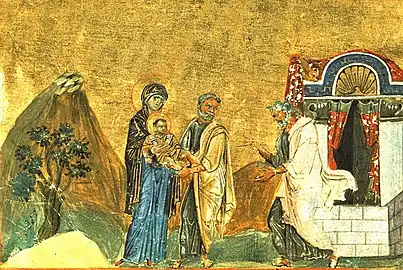 Circumcision of Christ. Menologion of Basil II.
Circumcision of Christ. Menologion of Basil II.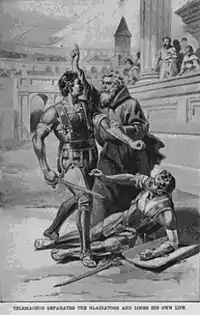 St. Telemachus (from Foxe's Bok of Martyrs, 1563).
St. Telemachus (from Foxe's Bok of Martyrs, 1563). St. Basil the Great.
St. Basil the Great.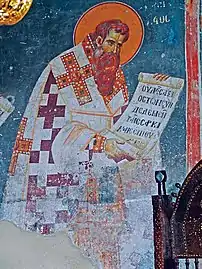 Fresco of St. Basil the Great, lower register of sanctuary in Church of the Theotokos Peribleptos in Ohrid (13th century).
Fresco of St. Basil the Great, lower register of sanctuary in Church of the Theotokos Peribleptos in Ohrid (13th century).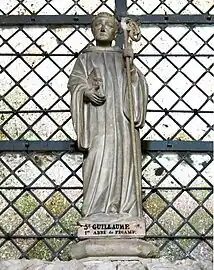 St. William of Volpiano, statue above his tomb in Fécamp Abbey.
St. William of Volpiano, statue above his tomb in Fécamp Abbey.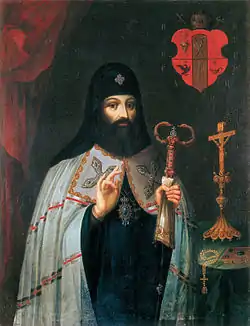 St. Peter Mogila, Metropolitan of Kiev and Galica (17th century).
St. Peter Mogila, Metropolitan of Kiev and Galica (17th century).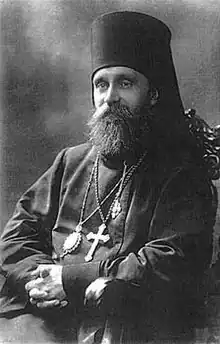 St. Platon (Kulbush), Bishop of Tallinn (Reval), Estonia.
St. Platon (Kulbush), Bishop of Tallinn (Reval), Estonia.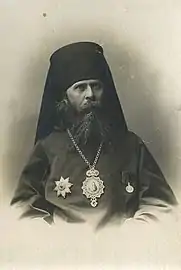 New Hieromartyr Alexander (Trapitsyn), Archbishop of Samara.
New Hieromartyr Alexander (Trapitsyn), Archbishop of Samara.
Notes
- The notation Old Style or (OS) is sometimes used to indicate a date in the Julian Calendar (which is used by churches on the "Old Calendar").
The notation New Style or (NS), indicates a date in the Revised Julian calendar (which is used by churches on the "New Calendar"). See also Old Style and New Style dates - "The CIRCUMCISION of Our Lord and Saviour JESUS CHRIST, by virtue of Whose Adorable Blood-shedding, a glorious host of Saints, Martyrs, Confessors, Virgins – men and women of every degree – as well in this land as throughout Christendom, kept the Faith, persevered unto death in their holy course, and in the end received the crown, at the hands of the Just Judge."[4]
- "THE Circumcision of our Lord Jesus Christ, and the Octave of His Nativity."[5]
- This saint, a layman, should not be confused with the other St Basil of Ancyra, who was a priest (March 22).
- Churches of the Russian tradition keep her feast on January 1, along with her son Basil. Greek churches keep her feast on May 8 or May 30, along with her husband Saint Basil the Elder and her mother-in-law, Saint Macrina the Elder.
- In Greek tradition, his name was given to Father Christmas and he is supposed to visit children and give presents every January 1 (St Basil's Day) — unlike other traditions where Saint Nicholas arrives either on December 6 (Saint Nicholas Day) or on Christmas Eve (December 24). It is traditional on St Basil's Day to serve "Vasilopita", a rich bread baked with a coin inside. It is customary on his feast day to visit the homes of friends and relatives, to sing New Year carols, and to set an extra place at the table for Saint Basil. In Greek tradition and according to historical records, St Basil, of Greek heritage, is the original "Father Christmas", who being born into a wealthy family, gave away all his possessions to the poor and those in need, the underprivileged and children. A similar story exists for another Greek bishop, St. Nicholas of Myra. Over the centuries the two have been merged but the Western "Santa Claus" is St. Nicholas and the Eastern "Santa Claus" is St. Basil.
- St Vassily is the baptismal patron of St Volodymyr the Great, and iconography of the enlightener of Rus’-Ukraine sometimes depicts him as St Basil, teaching the faith to the people.
- The Venerable Theodosius was Abbot at one of the four famed monasteries of Triglia.
(in Greek) Ὁ Ὅσιος Θεοδόσιος ἦταν ἡγούμενος σὲ μία ἀπὸ τὶς τέσσερις φημισμένες Μονὲς τῆς Τριγλίας, τοῦ Μιδηκίου, τοῦ Βαθέως Ρύακος, τοῦ Ἁγίου Στεφάνου καὶ τοῦ Ἁγίου Ἰωάννου. Κοιμήθηκε Ὁσίως μὲ εἰρήνη. - "At Spoleto, in the time of the emperor Antoninus, St. Concordius, priest and martyr, who was beaten with clubs, and then put to the torture. After a long confinement in prison, where he was visited by an angel, he lost his life by the sword."[5]
- "In the same city, on the Appian way, the crowning with martyrdom of thirty holy soldiers, under the emperor Diocletian."[5]
- "At Rome, St. Almachius, martyr, who, by the command of Alipius, governor of the city, was killed by the gladiators for saying, "Today is the Octave of our Lord's birth; put an end to the worship of idols, and abstain from unclean sacrifices."[5]
- She founded a convent at Rossory in Fermanagh and was buried in Killane.
- "In Africa, St. Fulgentius, bishop of Ruspoe, who suffered much from the Arians during the persecution of the Vandals, for holding the Catholic faith and teaching its excellent doctrine. After being banished to Sardinia, he was permitted to return to his diocese, where he ended his life by a holy death, leaving a reputation for sanctity and eloquence."[5]
- "At Chieti, in Abruzzo, the birthday of St. Justin, bishop of that city, illustrious for holiness of life and miracles."[5] In the language of the Church, birthday refers to the day on which a Saint enters heaven. However, the Blessed Virgin and St. John the Baptist are exceptions to this rule.
References
- Great Synaxaristes: (in Greek) Περιτομὴ τοῦ Ἰησοῦ Χριστοῦ. 1 Ιανουαρίου. ΜΕΓΑΣ ΣΥΝΑΞΑΡΙΣΤΗΣ.
- The Circumcision of our Lord and Savior Jesus Christ. OCA - Feasts and Saints.
- Very Rev. John O'Hanlon. "Article XX.—Feast of the Circumcision of our Lord." In: Lives of the Irish Saints: With Special Festivals, and the Commemorations of Holy Persons. VOL. I. Dublin, 1875. pp. 26-27.
- Rev. Richard Stanton. A Menology of England and Wales, or, Brief Memorials of the Ancient British and English Saints Arranged According to the Calendar, Together with the Martyrs of the 16th and 17th Centuries. London: Burns & Oates, 1892. p.1.
- The Roman Martyrology. Transl. by the Archbishop of Baltimore. Last Edition, According to the Copy Printed at Rome in 1914. Revised Edition, with the Imprimatur of His Eminence Cardinal Gibbons. Baltimore: John Murphy Company, 1916. pp. 1-3.
- Great Synaxaristes: (in Greek) Ὁ Ἅγιος Θεόδοτος. 1 Ιανουαρίου. ΜΕΓΑΣ ΣΥΝΑΞΑΡΙΣΤΗΣ.
- January 14 / January 1. HOLY TRINITY RUSSIAN ORTHODOX CHURCH (A parish of the Patriarchate of Moscow).
- Martyr Basil of Ancyra. OCA - Feasts and Saints.
- Great Synaxaristes: (in Greek) Ὁ Ἅγιος Γρηγόριος. 1 Ιανουαρίου. ΜΕΓΑΣ ΣΥΝΑΞΑΡΙΣΤΗΣ.
- January 1/14. Orthodox Calendar (PRAVOSLAVIE.RU).
- St Emilia, the Mother of St Basil the Great. OCA - Feasts and Saints.
- Great Synaxaristes: (in Greek) Ὁ Ἅγιος Βασίλειος ὁ Μέγας ὁ Καππαδόκης. 1 Ιανουαρίου. ΜΕΓΑΣ ΣΥΝΑΞΑΡΙΣΤΗΣ.
- St Basil the Great the Archbishop of Caesarea, in Cappadocia. OCA - Feasts and Saints.
- Great Synaxaristes: (in Greek) Ὁ Ὅσιος Θεοδόσιος. 1 Ιανουαρίου. ΜΕΓΑΣ ΣΥΝΑΞΑΡΙΣΤΗΣ.
- January 1. Latin Saints of the Orthodox Patriarchate of Rome.
- Very Rev. John O'Hanlon. "ARTICLE I.—ST. FANCHEA, VIRGIN, ABBESS OF ROSS OIRTHER, OR ROSSORY, COUNTY OF FERMANAGH, AND OF KILLANY, COUNTY OF LOUTH. [FIFTH AND SIXTH CENTURY.]." In: Lives of the Irish Saints: With Special Festivals, and the Commemorations of Holy Persons. VOL. I. Dublin, 1875. pp. 1-11.
- Very Rev. John O'Hanlon. "Article XIV.—St. Connat, or Comnatan, Abbess of Kildare, County of Kildare. [Sixth Century.]." In: Lives of the Irish Saints: With Special Festivals, and the Commemorations of Holy Persons. VOL. I. Dublin, 1875. pp. 24-25.
- Very Rev. John O'Hanlon. "Article XI.—Feast of St. Mochua, or Cuan, Abbot and Patron of Teach-Mochua, or Timahoe, Queen's County. [Sixth or Seventh Century.]." In: Lives of the Irish Saints: With Special Festivals, and the Commemorations of Holy Persons. VOL. I. Dublin, 1875. pp. 23-24.
- The Autonomous Orthodox Metropolia of Western Europe and the Americas (ROCOR). St. Hilarion Calendar of Saints for the year of our Lord 2004. St. Hilarion Press (Austin, TX). p.4.
- "The Orthodox Faith - Volume III - Church History - Seventeenth Century - Saint Peter Mogila". www.oca.org. Retrieved 2023-04-08.
- Great Synaxaristes: (in Greek) Ὁ Ἅγιος Πέτρος ὁ Πελοποννήσιος. 1 Ιανουαρίου. ΜΕΓΑΣ ΣΥΝΑΞΑΡΙΣΤΗΣ.
- RUSSIAN CHURCH ADDS 30 LOCALLY-VENERATED SAINTS TO CHURCH-WIDE CALENDAR. Orthodox Christianity. December 1, 2017.
- (in Russian) 1 января (ст.ст.) 14 января 2013 (нов. ст.) Archived 2019-01-27 at the Wayback Machine. Русская Православная Церковь Отдел внешних церковных связей. (DECR).
- Great Synaxaristes: (in Greek) Ὁ Ἅγιος Πλάτων ὁ Ἱερομάρτυρας καὶ οἱ σὺν αὐτῷ. 1 Ιανουαρίου. ΜΕΓΑΣ ΣΥΝΑΞΑΡΙΣΤΗΣ.
Sources
- January 1/14. Orthodox Calendar (PRAVOSLAVIE.RU).
- January 14 / January 1. HOLY TRINITY RUSSIAN ORTHODOX CHURCH (A parish of the Patriarchate of Moscow).
- January 1. OCA - The Lives of the Saints.
- January 1. Latin Saints of the Orthodox Patriarchate of Rome.
- The Roman Martyrology. Transl. by the Archbishop of Baltimore. Last Edition, According to the Copy Printed at Rome in 1914. Revised Edition, with the Imprimatur of His Eminence Cardinal Gibbons. Baltimore: John Murphy Company, 1916. pp. 1–3.
- Rev. Richard Stanton. A Menology of England and Wales, or, Brief Memorials of the Ancient British and English Saints Arranged According to the Calendar, Together with the Martyrs of the 16th and 17th Centuries. London: Burns & Oates, 1892. p. 1.
Greek Sources
- Great Synaxaristes: (in Greek) 1 ΙΑΝΟΥΑΡΙΟΥ. ΜΕΓΑΣ ΣΥΝΑΞΑΡΙΣΤΗΣ.
- (in Greek) Συναξαριστής. 1 Ιανουαρίου. ECCLESIA.GR. (H ΕΚΚΛΗΣΙΑ ΤΗΣ ΕΛΛΑΔΟΣ).
Russian Sources
- (in Russian) 14 января (1 января). Православная Энциклопедия под редакцией Патриарха Московского и всея Руси Кирилла (электронная версия). (Orthodox Encyclopedia - Pravenc.ru).
- (in Russian) 1 января (ст.ст.) 14 января 2013 (нов. ст.) Archived 2019-01-27 at the Wayback Machine. Русская Православная Церковь Отдел внешних церковных связей. (DECR).
This article is issued from Wikipedia. The text is licensed under Creative Commons - Attribution - Sharealike. Additional terms may apply for the media files.

